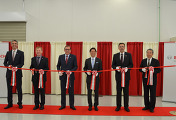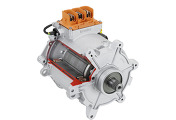STUTTGART – In the coming years, the automobile will undergo major changes. “The traffic of the future is electric, automated, and connected,” said Dr. Volkmar Denner, the chairman of the Bosch board of management, during his March 18 presentation at “Automotive and Engine Technology,” the 14th Stuttgart International Symposium. “Automated driving can drastically reduce the number of accidents, and thus significantly increase road safety,” Denner said. “Moreover, a better flow of traffic also reduces fuel consumption.” Today, assistance functions are already assuming a broad range of driving functions. In the future, even higher-performance systems will provide drivers with increasingly comprehensive support, and gradually pave the way for fully automated driving.
The Bosch CEO highlighted the benefits of automated driving, and set out the challenges that still need to be solved. “The prospect of saving 1.2 million lives is a great source of motivation,” Denner said, in reference to the estimated number of road traffic deaths around the world each year. In Germany, almost 90 percent of all traffic accidents are caused by drivers. Here, comprehensive support in critical situations as well as in monotonous driving situations could significantly increase road safety. But more than that, automated driving is also economical. By drawing on up-to-the-minute traffic data, it can improve the flow of traffic and thus decrease the fuel consumption of every vehicle. And last, but not least: “Automated driving also keeps senior citizens mobile, and thus makes a contribution to social well-being,” Denner said.
Automated driving will come gradually
For more than ten years, adaptive cruise control has automatically controlled speed, as well as distance to vehicles ahead. The traffic jam assistant, which keeps vehicles travelling at speeds up to 60 kph in their lanes, is now being brought to market. This support for drivers will gradually be extended. “By 2020 at the latest, the technologies required for highly-automated driving will reach maturity. In the decade that follows, we expect to see fully-automated driving,” Denner said. While drivers in highly automated vehicles must take control of the vehicles after a short time, fully automated driving will allow them to sit back and let the car do the work, at least on freeways. And Bosch will be automating parking even sooner. Bosch technology will soon be easing cars into free parking spots autonomously via a smart phone app. In a few years, cars will even be able to find spots on their own in parking garages.
While technical limitations mean that the pace of development is gradual, this does have its advantages. “It gives drivers the time to gradually grasp the benefits of the new technology,” Denner said. Today’s drivers already show openness to these innovations. A Bosch survey in six European countries showed that 59 percent of respondents considered automated driving to be a good thing. However, they wanted to be able to actively switch it off. In purely economic terms, the market for driver assistance technologies is already an attractive one with excellent growth prospects. “By 2016, Bosch will be generating one billion euros in sales with driver assistance systems,” Denner said.
The Bosch “Automated Driving” project team was formed in 2011, and has since been working in Stuttgart and Palo Alto on the future of driving. And at the start of 2013, Bosch was the first automotive supplier to bring its automated driving technologies to German freeways. “The early tests in real traffic conditions have significantly sped up the development process,” Denner said.
Automated driving requires broad systems expertise
In the coming years, Bosch engineers still have a broad range of tasks ahead of them, as automated driving has an impact on all vehicle systems. “Only automakers and suppliers with broad systems expertise will succeed,” Denner said. The Bosch CEO summarized the five main development priorities as follows:
- Sensor concepts for 360° environment recognition:
What types of sensor technologies are needed to capture the vehicle’s surroundings well enough to recommend the right actions? Bosch has already sold more than a million radar and video sensors. The company is drawing on this experience to develop high-performance yet economical environment recognition technology that will satisfy the demands of automated driving. - Redundant system architecture:
To maintain maximum availability in the event that one component fails, there will be a change in vehicle architecture. Bosch has already come up with the required redundancy for brakes, for instance. The iBooster electromechanical brake booster and the ESP system can bring the vehicle to a stop autonomously, independently of one another. - Reliability in the event of malfunction and hacking:
To check functional reliability, Bosch applies high-performance methods. However, the subsequent validation calls for new approaches if the effort of validating an autopilot system is to be kept at today’s level. Using the methods applied today, more than 250 million test kilometers would have to be driven. To protect vehicle systems from hacking, Bosch already relies on a dual architecture that keeps the infotainment features in the automotive electrical system separate from the systems required for driving. In addition, the electronics expert offers complementary hard- and software-based solutions for data security and access protection. “The automotive industry needs clear, consistent data-protection and data-security regulations,” Denner said. - High-precision map data:
While accuracy to the nearest meter is more than sufficient for current navigation systems, this is not sufficient for fully automated driving. For the latter, accuracy to the nearest ten centimeters are required. Moreover, the maps must be completely up to date to ensure that the vehicle can anticipate the correct route and stay on course. - Legal regulations:
According to the Vienna Convention of 1968, which serves as the basis for legislation in many countries around the world, only partly automated driving is legal. “Authorization regimes and questions related to product liability are currently the subject of intense debate among associations, governments, and insurance companies,” Denner said.
Automotive Technology is the largest Bosch Group business sector. According to preliminary figures, its 2013 sales came to 30.7 billion euros, or 66 percent of total group sales. This makes the Bosch Group one of the leading automotive suppliers (note: due to a change in the legal rules governing consolidation, the 2013 figures can only be compared to a limited extent with the 2012 figures). Automotive Technology largely operates in the following areas: injection technology for internal-combustion engines, alternative powertrain concepts, efficient and networked powertrain peripherals, systems for active and passive driving safety, assistance and comfort functions, technology for user-friendly infotainment as well as car-to-car and Car2X communication, and concepts, technology, and service for the automotive aftermarket. Bosch has been responsible for important automotive innovations, such as electronic engine management, the ESP® anti-skid system, and common-rail diesel technology.
The Bosch Group is a leading global supplier of technology and services. According to preliminary figures, its roughly 281,000 associates generated sales of 46.4 billion euros in 2013 (Note: due to a change in the legal rules governing consolidation, the 2013 figures can only be compared to a limited extent with the 2012 figures). Its operations are divided into four business sectors: Automotive Technology, Industrial Technology, Consumer Goods, and Energy and Building Technology. The Bosch Group comprises Robert Bosch GmbH and its more than 360 subsidiaries and regional companies in some 50 countries. If its sales and service partners are included, then Bosch is represented in roughly 150 countries. This worldwide development, manufacturing, and sales network is the foundation for further growth. In 2013, Bosch applied for some 5,000 patents worldwide. The Bosch Group’s products and services are designed to fascinate, and to improve the quality of life by providing solutions which are both innovative and beneficial. In this way, the company offers technology worldwide that is “Invented for life.”
Further information is available online at www.bosch.com and www.bosch-press.com, http://twitter.com/BoschPresse.
PI8517 - March 18, 2014
/ Photo & Report provided by Bosch Press Release - sujung.jang@kr.bosch.com
/ MediaPaper.KR mediapaper@ymail.com Sejin Oh
/ The News Article was written by receiving a Press Release.
'Car > BOSCH' 카테고리의 다른 글
| Bosch reaps the dividends of gasoline direct injection (0) | 2014.04.07 |
|---|---|
| New site for Bosch Packaging Technology (0) | 2014.04.04 |
| 100 years of Bosch starter motors (0) | 2014.03.17 |
| The new American way of driving - downsizing, diesel, and electrical powertrains gain momentum (0) | 2014.03.14 |
| “Realizing economies of scale in how we grow our knowledge base” (0) | 2014.03.13 |







댓글